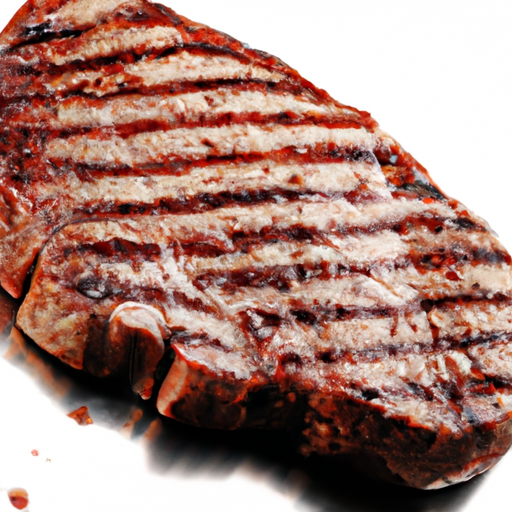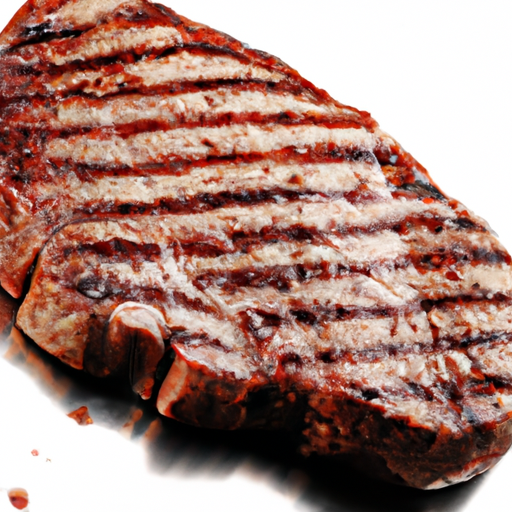If you’ve ever found yourself standing in the meat aisle, unsure of which steak to buy, worry no more! Introducing “A Guide to Cooking Steak: Thickness Chart.” This handy tool provides you with a comprehensive chart that takes the guesswork out of cooking the perfect steak. With precise recommendations for different thicknesses, you’ll be able to achieve that juicy, tender steak every time. So whether you’re a grilling enthusiast or a novice in the kitchen, this guide is a must-have for all steak lovers. Say goodbye to overcooked or undercooked steaks and say hello to perfectly cooked, mouthwatering goodness!
Choosing the Right Cut of Steak
When it comes to preparing a delicious steak, choosing the right cut is crucial. Different cuts offer different flavors, textures, and levels of tenderness, so it’s important to understand the variations before making your decision.
Understanding Different Cuts
Steaks come in a variety of cuts, each offering its own unique qualities. Some popular cuts include ribeye, filet mignon, strip steak, T-bone, and skirt steak. Ribeye is known for its rich marbling and intense flavor, while filet mignon is prized for its tenderness. Strip steak, T-bone, and skirt steak offer a balance of tenderness and flavor.
Selecting the Best Cut for Your Preferences
When selecting a cut of steak, consider your personal preferences. If you enjoy a juicy, flavorful steak with a bold taste, ribeye might be your best choice. On the other hand, if tenderness is your top priority, filet mignon is the way to go. Take some time to research and explore the characteristics of different cuts to find the one that aligns with your taste preferences.
Considering Budget and Availability
Another crucial factor to consider when choosing a cut of steak is your budget and the availability of certain cuts. Prime cuts like ribeye and filet mignon tend to be pricier, while cuts like strip steak and skirt steak are often more affordable. Additionally, certain cuts may be more readily available depending on your location. It’s important to balance your preferences with your budget and the availability of different cuts to ensure a satisfying steak experience.
Determining the Thickness of Your Steak
The thickness of your steak can greatly impact its cooking time and overall doneness. Understanding the importance of steak thickness and how to measure it properly is essential for achieving the perfect steak.
Importance of Steak Thickness
The thickness of a steak plays a crucial role in determining its final result. Thicker steaks take longer to cook and require different cooking techniques compared to thinner cuts. It’s essential to consider the thickness before deciding on the cooking method and timing.
Measuring the Thickness
To accurately measure the thickness of your steak, use a ruler or a tape measure. Place the steak on a flat surface and measure from one side to the other, vertically through the center of the steak. This will give you the most accurate measurement, helping you determine the cooking time and temperature required.
Common Thickness Ranges for Different Cuts
The thickness of steaks can vary depending on the cut. While there are no hard and fast rules, here are some common thickness ranges for different cuts:
- Ribeye: 1 to 1 1/2 inches
- Filet Mignon: 1 to 2 inches
- Strip Steak: 1 to 1 1/2 inches
- T-bone: 1 1/2 to 2 inches
- Skirt Steak: 1/4 to 1/2 inch
These are just general guidelines, and personal preferences may vary. It’s always best to consult a recipe or trusted source for specific recommendations on steak thickness.

Factors Affecting Cooking Time and Temperature
Cooking a steak to perfection involves considering various factors that can affect the cooking time and temperature. Beyond just the thickness of the steak, you should understand how other factors come into play.
Steak Thickness and Cooking Time
As mentioned earlier, the thickness of the steak is a significant factor in determining cooking time. Thinner steaks will cook faster, while thicker cuts will take longer. This is because thicker steaks require more time for the heat to penetrate the center and achieve the desired doneness.
Steak Thickness and Internal Temperature
The thickness of the steak also affects the internal temperature at which it reaches the desired doneness. Thicker steaks generally have a larger temperature gradient from the outer seared crust to the center. This means that thicker steaks need to be cooked for a longer time to ensure the center reaches the desired level of doneness without overcooking the outer layers.
Other Factors to Consider
While thickness is an important factor, there are other considerations that can impact cooking time and temperature. The initial temperature of the steak when it is placed on the cooking surface, the cooking method used (grilling, pan-searing, sous vide, etc.), and even the altitude at which you are cooking can all influence the cooking process. It’s important to take these factors into account when determining the optimal cooking time and temperature for your steak.
Cooking Techniques for Different Thicknesses
Steaks of different thicknesses require different cooking techniques to ensure they are cooked to perfection. Let’s explore the recommended techniques for various thickness ranges.
Extremely Thin Steaks (1/2 inch or less)
Extremely thin steaks are best suited for high-heat cooking methods, such as pan-searing or grilling over direct heat. These steaks cook quickly and benefit from a short cooking time to avoid overcooking and drying out.
Thin Steaks (1/2 – 1 inch)
Thin steaks also work well with high-heat cooking methods. Pan-searing or grilling over direct heat for a short amount of time, typically a few minutes per side, is recommended to achieve a desired level of doneness without overcooking.
Medium Steaks (1 – 1 1/2 inches)
Medium steaks can be cooked using a combination of high-heat cooking methods and gentle indirect heat. Start by searing the steak on high heat to develop a flavorful crust, then finish cooking on lower heat or in the oven to allow the center to reach the desired temperature.
Thick Steaks (1 1/2 – 2 inches)
Thick steaks benefit from a two-step cooking process to ensure even cooking throughout. Begin by searing the steak on high heat, then transfer it to the oven at a lower temperature to continue cooking until the desired doneness is achieved. This technique helps the center reach the desired temperature without overcooking the outer layers.
Extra Thick Steaks (2 inches or more)
Extra thick steaks require a similar approach to thick steaks, but with a longer cooking time. Sear the steak on high heat to develop a crust, then transfer it to the oven at a lower temperature for a more extended period. This allows the thicker cut to cook evenly while still achieving the desired internal temperature.

Preferred Doneness Levels for Steaks
Before cooking your steak, it’s essential to determine your preferred level of doneness. The doneness level affects the texture, juiciness, and flavor of the steak. Here are some common preferences:
Rare
Rare steaks have a cool-red center and are cooked to an internal temperature of 125°F to 130°F (51°C to 54°C). The exterior is seared, creating a browned crust while preserving the juices and tenderness of the meat.
Medium Rare
Medium rare steaks have a warm-red center and are cooked to an internal temperature of 130°F to 135°F (54°C to 57°C). This is a popular level of doneness as it maintains a balance between tenderness, juiciness, and a slightly more pronounced flavor.
Medium
Medium steaks have a pink center and are cooked to an internal temperature of 135°F to 145°F (57°C to 63°C). This level of doneness offers a slightly less tender steak with more moisture and a bit less pronounced meaty flavor.
Medium Well
Medium well steaks have a slightly pink center and are cooked to an internal temperature of 145°F to 155°F (63°C to 68°C). At this level of doneness, the steak is less juicy and slightly firmer, with a more well-cooked and browned exterior.
Well Done
Well done steaks are cooked to an internal temperature of 155°F and above (68°C and above). They have no pinkness in the center and are fully cooked throughout. Well done steaks tend to be drier and less tender compared to the other levels of doneness.
Cooking Times and Temperatures for Different Thicknesses
Achieving the perfect doneness for your steak requires understanding the optimal cooking times and temperatures based on the thickness of the cut. Use these general guidelines as a starting point, but always rely on a meat thermometer for accurate results.
Cooking Times for Rare Steaks
For a rare steak:
- Extremely thin steaks (1/2 inch or less): 1-2 minutes per side
- Thin steaks (1/2 – 1 inch): 2-3 minutes per side
- Medium steaks (1 – 1 1/2 inches): 3-4 minutes per side
- Thick steaks (1 1/2 – 2 inches): 4-5 minutes per side
- Extra thick steaks (2 inches or more): 5-6 minutes per side
Cooking Times for Medium Rare Steaks
For a medium rare steak:
- Extremely thin steaks (1/2 inch or less): 2-3 minutes per side
- Thin steaks (1/2 – 1 inch): 3-4 minutes per side
- Medium steaks (1 – 1 1/2 inches): 4-5 minutes per side
- Thick steaks (1 1/2 – 2 inches): 5-6 minutes per side
- Extra thick steaks (2 inches or more): 6-7 minutes per side
Cooking Times for Medium Steaks
For a medium steak:
- Extremely thin steaks (1/2 inch or less): 3-4 minutes per side
- Thin steaks (1/2 – 1 inch): 4-5 minutes per side
- Medium steaks (1 – 1 1/2 inches): 5-6 minutes per side
- Thick steaks (1 1/2 – 2 inches): 6-7 minutes per side
- Extra thick steaks (2 inches or more): 7-8 minutes per side
Cooking Times for Medium Well Steaks
For a medium well steak:
- Extremely thin steaks (1/2 inch or less): 4-5 minutes per side
- Thin steaks (1/2 – 1 inch): 5-6 minutes per side
- Medium steaks (1 – 1 1/2 inches): 6-7 minutes per side
- Thick steaks (1 1/2 – 2 inches): 7-8 minutes per side
- Extra thick steaks (2 inches or more): 8-9 minutes per side
Cooking Times for Well Done Steaks
For a well done steak:
- Extremely thin steaks (1/2 inch or less): 6-8 minutes per side
- Thin steaks (1/2 – 1 inch): 8-10 minutes per side
- Medium steaks (1 – 1 1/2 inches): 10-12 minutes per side
- Thick steaks (1 1/2 – 2 inches): 12-14 minutes per side
- Extra thick steaks (2 inches or more): 14-16 minutes per side
Resting and Slicing Your Steak
Once your steak is cooked to perfection, it’s important to let it rest before serving. Resting allows the juices to redistribute, resulting in a more tender and flavorful steak.
Importance of Resting
Resting your steak is essential to achieve optimal results. When cooked, the heat causes the juices to migrate towards the center of the steak. By letting the steak rest for a few minutes, the juices have time to redistribute, resulting in a more even distribution of moisture throughout the meat.
How to Rest Your Steak
To rest your steak properly, remove it from the heat source and transfer it to a clean cutting board or serving platter. Tent the steak loosely with aluminum foil to help retain heat. Let the steak rest for about 5-10 minutes, depending on its thickness. This resting period will enhance the tenderness and juiciness of the steak.
Slicing Techniques for Different Cuts
The technique for slicing your steak varies depending on the cut. For thinner cuts like skirt steak or filet mignon, slicing against the grain (perpendicular to the muscle fibers) helps maximize tenderness. Thicker cuts like ribeye or strip steak can be sliced into individual portions or served as larger cuts for sharing. When slicing, use a sharp knife and make clean, smooth cuts to preserve the integrity of the steak.
Popular Steak Recipes and Recommendations
While the cooking times and techniques may vary depending on your personal preferences, here are some popular recipes and recommendations for cooking steaks:
Classic Grilled Ribeye
For a classic grilled ribeye, start by preheating your grill to high heat. Season the steak generously with salt and pepper, then place it on the hot grill. Cook for about 4-5 minutes per side for medium-rare, adjusting the time for your preferred level of doneness. Let the steak rest before slicing and serving.
Pan-Seared Filet Mignon
To pan-sear filet mignon, heat a skillet over medium-high heat and add a tablespoon of oil or butter. Season the steak with salt and pepper, then place it in the hot skillet. Cook for about 4-5 minutes per side for medium-rare, adjusting the time as needed. Let the steak rest before slicing and serving.
Sous Vide Strip Steak
For a sous vide strip steak, season the steak with salt, pepper, and any desired herbs or spices. Place the steak in a vacuum-sealed bag and cook it in a water bath at a precise temperature (usually around 130°F to 135°F) for a few hours. Once cooked, sear the steak on a hot grill or in a skillet to develop a flavorful crust. Let the steak rest before slicing and serving.
Reverse Sear T-Bone
The reverse sear method is great for thick cuts like T-bone steaks. Preheat your oven to a low temperature (around 225°F) and place the steak on a wire rack set inside a baking sheet. Cook the steak in the oven until it reaches an internal temperature of about 10°F below your desired doneness. Finish the steak by searing it on high heat in a skillet for a few minutes per side. Let the steak rest before slicing and serving.
Marinated Skirt Steak
To infuse flavor into a skirt steak, create a marinade using ingredients like soy sauce, garlic, lime juice, and spices. Place the steak in a resealable plastic bag and pour the marinade over it. Allow the steak to marinate in the refrigerator for at least 1-2 hours, or preferably overnight. Grill the steak over high heat for about 2-3 minutes per side, adjusting the time as needed. Let the steak rest before slicing and serving.
Recipe-Specific Recommendations for Thicknesses
While the cooking times and techniques above provide general guidelines, some recipes may have specific recommendations for different thicknesses. Here are a few key examples:
Recommended Thickness for Grilled Ribeye
For a grilled ribeye, a thickness range of 1 to 1 1/2 inches is commonly recommended. This thickness allows for a good balance between cooking time and achieving the desired level of doneness without compromising tenderness.
Recommended Thickness for Pan-Seared Filet Mignon
Filet mignon is often recommended at a thickness of 1 to 2 inches for pan-searing. This allows for a tender steak with an even crust, while still maintaining a desirable level of doneness.
Recommended Thickness for Sous Vide Strip Steak
When using the sous vide method, a thickness of 1 to 1 1/2 inches is often recommended for strip steak. This thickness ensures even cooking throughout the steak while allowing enough time for the flavors to infuse.
Recommended Thickness for Reverse Sear T-Bone
For the reverse sear method, a thickness of 1 1/2 to 2 inches is commonly recommended for T-bone steaks. This thickness allows for the ideal temperature gradient from the outer crust to the center of the steak.
Recommended Thickness for Marinated Skirt Steak
For marinated skirt steak, a thickness of 1/4 to 1/2 inch is often preferred. This thin cut benefits from a shorter cooking time to maintain tenderness and avoid drying out.
Tips and Tricks for Perfectly Cooked Steaks
To achieve perfectly cooked steaks every time, consider these helpful tips and tricks:
Bringing Steak to Room Temperature
Before cooking, allow your steak to come to room temperature by letting it sit at room temperature for about 30 minutes. This ensures more even cooking throughout the steak.
Seasoning and Marinating Tips
When it comes to seasoning steaks, use a generous amount of salt and freshly ground pepper on all sides of the steak before cooking. For marinades, consider incorporating ingredients like garlic, herbs, and acid-based liquids to enhance the flavor and tenderness.
Using a Meat Thermometer
To ensure precise results, use a meat thermometer to check the internal temperature of your steak. Insert the thermometer into the thickest part of the steak without touching bone or the cooking surface.
Resting and Tenting
Remember to let your steak rest after cooking to allow the juices to redistribute. Tenting the steak loosely with foil helps retain heat while resting.
Creating a Flavorful Crust
For a mouthwatering crust, make sure your cooking surface is hot before adding the steak. This helps create a beautiful sear and enhances the overall flavor of the steak.
By understanding the different cuts of steak, determining the thickness, considering cooking times and temperatures, and following suitable techniques, you can confidently cook a steak to perfection. Experiment with different recipes, flavors, and methods to find your favorite way to enjoy this classic dish. So fire up that grill or preheat that skillet, and get ready to savor a deliciously cooked steak tailored to your preferences!
